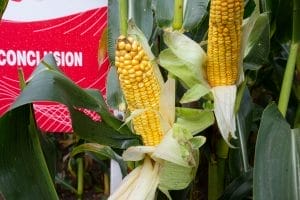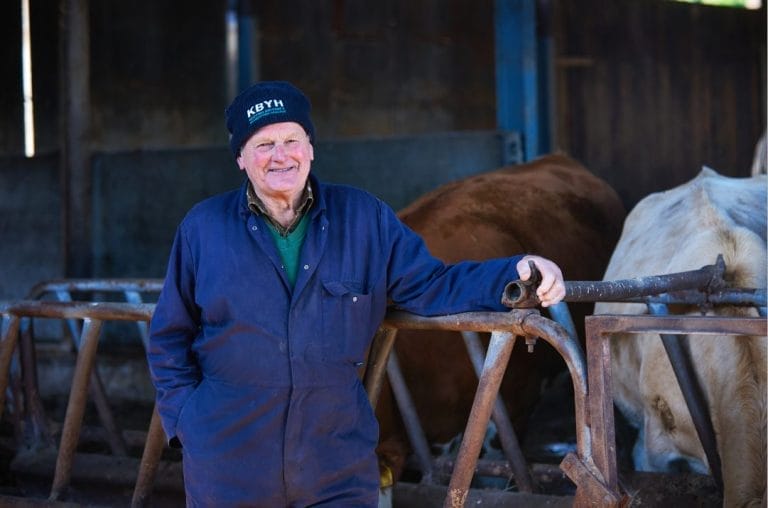
Maintaining target growth rates in a beef finishing enterprise requires a year-round ration that is well-balanced, high in energy and easily digestible. For Yorkshire farmer Edward Liversidge, based at Primrose Hill Farm, High Catton, the key is to feed a total mixed ration based on high quality maize, with the crop being grown as a fully integrated part of the farm’s arable rotation.
Success comes from the Liversidge family’s years of experience of growing maize and it starts with selecting the right variety for the job.
“First and foremost, we want a variety that is going to perform in our situation, which means it needs to be compatible with our soils and location,” says Edward. “Alongside this, we’re looking for good D-value, ME and starch, because it’s the nutritional value that will drive growth rates.”
York-based agricultural trading company Argrain are the Liversidge’s seed suppliers, with seed specialist Lucy Leedham being trusted to make the right recommendations due to her local knowledge and experience. For the 2023 season, she introduced Limagrain’s first choice early variety Conclusion, highly ranked for ME yield and cell wall digestibility and with the right maturity class for this area.
“Conclusion has performed well in our local trials, and we’ve generally had good feedback on it in our area,” says Lucy. “It’s a very good all-round variety, offering the combination of high yields alongside nutritional quality that this farm demands. It also has the attributes to be grown successfully for grain, in that it is not quick die back and has good standability, which is an option that I know the Liversidges like to have.”
Growing as much as 150 acres of maize each year, the policy at Primrose Hill Farm is to grow two varieties, partly to spread risk, but they do it in a way that ensures a consistent feed is available all year round.
“We tend to split the contractor’s 8-row drill to grow alternating 4-row strips of two different varieties, which – when cut with a 12-row forage harvester – creates a consistent blend in the clamp,” explains Edward. “We’ve combined Conclusion with another high energy variety of similar maturity and achieved an overall fresh weight yield of between 19 and 20 tonnes/acre.
“It’s analysed as we’d hoped, with high starch and digestibility, and is feeding well. It’s exactly what we need to achieve our target growth rates.”
The majority of the maize grown at Primrose Hill Farm is in rotation within the arable acreage, and usually follows an over-winter cover crop that will have been grazed by sheep on tack. The cover crop is geared to meeting the needs of all parties, including the grazier, and would typically include grazing rye and stubble turnips.
Once cover crops have been grazed off, there is plenty of time to spread farmyard manure and prepare a seedbed ahead of maize drilling, which will usually be towards the end of April. One of the routine jobs well ahead of drilling is soil sampling, with the analyses being used to determine any additional fertiliser applications.
“We’re testing our soils in order to create soil nutrient maps, which then allows us to apply phosphate and potassium at variable rates,” adds Edward. “We’ve been doing this for three or four years now, to improve our use of fertilisers and save costs where we can.
“We’re also applying a slow-release liquid nitrogen pre-emergence. This ensures that the crop can draw on nutrient reserves in the soil at the important growth stages, well beyond the point where it’s possible to drive into the crop to top-dress with a granular fertiliser.”
Herbicides are used according to the weed burden in any particular crop, with either one or two applications required.
With nutritional value of the maize the main priority, harvest is determined by cob maturity, and took place in 2023 just before the end of September. It was a bumper crop, and with the clamps at Primrose Hill Farm full, the decision was taken to cut some of the maize for grain.
 “We used a local contractor’s machine with a specialist header to harvest some of the maize for crimping,” says Edward. “This worked out really well and, thanks to the Conclusion being suited for taking as either grain or silage, has given us an additional high energy feed for the ration.”
“We used a local contractor’s machine with a specialist header to harvest some of the maize for crimping,” says Edward. “This worked out really well and, thanks to the Conclusion being suited for taking as either grain or silage, has given us an additional high energy feed for the ration.”
The Liversidge’s cattle enterprise involves buying in strong stores, usually British Blue or Angus crosses from dairy herds in the 400 to 500kg range. These are finished on a total mixed ration, to achieve finished liveweights of 670-720kg.
“We aim for a finishing period on the farm of 90-120 days, so we need a ration that is going to drive good growth rates,” concludes Edward. “Good quality maize silage is the basis for the ration, so growing a mature crop is essential. Success with the maize crop means the bigger proportion of what we’re feeding the cattle is homegrown.”


































